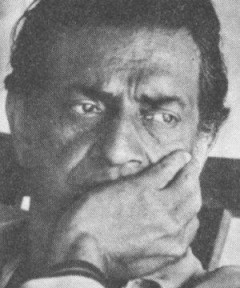Satyajit Ray, as a rule, visited the movies every Saturday afternoon. In this he was accompanied by a handful of like-minded ‘film-buffs’ he met and befriended. One of them was Bansi Chandragupta, who was destined to be Ray’s Art Director [a relationship that went on to collaborate on the most remarkable of Ray’s works upto Pratidwandi/The Adversary (1970), after which they parted ways, only to be re-united once, for Shatranj Ke Khilari/The Chess Players(1977); in addition to Ray’s cinema, Bansi also worked on such pathbreaking films as Kalyug (Shyam Benegal),Chakra (Rabindra Dharmaraj), Umrao Jaan (Muzaffar Ali), Tarang (Kumar Shahani), 36 Chowringhee Lane(Aparna Sen), 27 Down (Awtar Krishna Kaul)].
He was a Kashmiri painter who shared Ray’s passion for films and the concern about rampant mediocrity in Indian film-making. Another prominent name in the crowd was that of Chidananda Dasgupta. He was from Hazaribagh, where none of the theaters showed foreign films. He was yet to see Chaplin. He went on to become one of the renowned Bengali intellectuals, social commentator, film-critic, author and film maker. One of his greatest contributions to Indian cinema goes by the name of Aparna Sen, his daughter. These cinema fanatics and a few more who shared the passion, founded the Calcutta Film Society in 1948. They held regular private 16 mm screenings in their houses – the very first run being that of Sergei Eisenstein’s Classic Battleship Potemkin, with a print borrowed from the British Film Institute
In 1950, when Ray came back to India, an International Film Fest, first of its kind in the country was held. Films like Akira Kurosawa’s Rashomon, de Sica’s Miracle in Milan and Roberto Rosselini’s Open City were screened.
At the end of the festival, Ray was even more resolute to embark on a career in film making. For Pather Panchali, Ray never had a fully developed script/screenplay. The structure that he had in mind closely corresponded to the abridged version of the story. To facilitate adaptation, he did away with a lot of characters and made some not-so-insignificant changes to the basic storyline as part of his treatment. The way Ray visualised it, Pather Panchali was to have a different look than the run-of-the-mill Indian film. This made him do something that was to characterize the scripts of all his films – he drew detailed, elaborate sketches that would lay down the story in sequence: The Storyboard.
Ray realised he had to get the filming rights of the novel now. To his shock, Bibhutibhushan Bannerjee, the author of Pather Panchali passed away almost immediately after Ray’s return to the country. He met the widow of the deceased author. Mrs. Rama Bannerjee was an ardent admirer of Ray’s illustrious father and grandfather, and wasted no time in giving him a go-ahead. Once the rights were taken care of, the next problem Ray had to face was immeasurably more difficult and trickier: to look for a producer. This is what happened on his first attempt:
“The first person I approached was Mr. B.N. Sirkar, a sort of Bengali Louis B. Mayer, a true producer in the Hollywood sense. He owned a studio and a lab, New Theatres, and had on his payroll most of the leading actors and directors of Bengali cinema. Mr. Sirkar’s halycon days were past, but he was still a man to be reckoned with. I went to see him in his office with my sketchbook. A perfect gentleman, Mr. Sirkar received me cordially, gave full attention to what I had to say, then he said he was extremely sorry, but he had just launched a big production and wasn’t in a position to help me in any way. Then he clapped my shoulders affectionaterly and asked me to come back after six months – the next time, of course, he would try to help me.”
Next Ray approached almost all the ‘top producers’ of the Bengali film industry. Powerful as his presence was, everyone admitted that it was wonderful the way he narrated it, but being an ‘inexperienced director’, he would not realize ‘even 50 per cent of the idea’.
One of the producers approached was ‘one Mr. Bhattacharya’ (as Ray likes to refer to him) of Kalpana Movies. He listened to Ray, had a look at the sketches and said he was ineterested. He asked for 10 day’s time so that he could make his mind. Ray gleefully obliged. In three days, Bibhutibhushan’s brother in law Chandidas Chatterji informed him that ‘one Mr. Bhattacharya’ from Kalpana Movies had met Mrs. Bannerjee ‘to negotiate for the film rights of Pather Panchali to be directed by veteran director Debaki Bose. Mrs. Bannerjee, of course, rejected the offer and made it clear that she would not consider any alternatives other than Satyajit Ray. So ‘one Mr. Bhattacharya’ was thus discarded.
This was followed by another interview with….no, let’s have it from The Master Himself:
“This second disappointment was followed by a third one when a diabetic producer came to my house to listen to my treatment and interrupted my recital three times to visit the toilet. He liked the treatment but lacked the sense to sponsor something that was so drastically offbeat.”
Among this gloom, the only silver lining was that he already had the most passionate unit/crew in place: Bansi Chandragupta as Art Director (who had already worked on Renoir’s The River), Subrata Mitra, who had, by Renoir’s permission and Ray’s mentoring, observed Claude Renoir’s camera work on The River, as Cameraman, Dulal Duttaas Editor, Shanti Chatterji as Assistant, and Anil Choudhury as Production Manager.
But finances were still a long way off.
To be concluded…..






